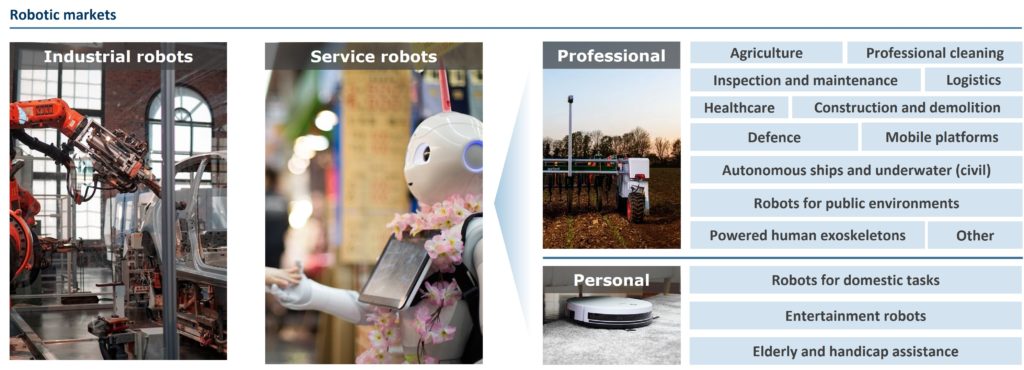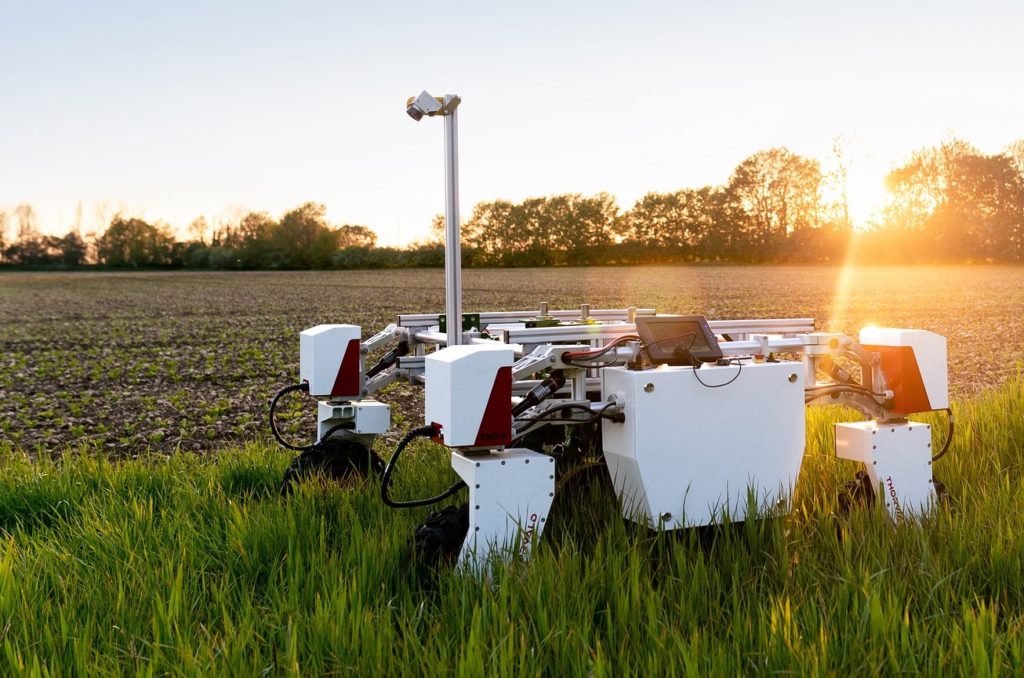Commercial traction in the robotics market
While industrial robotics is still the largest market segment in terms of annual revenues, it might be overtaken by service robots with its two main categories of professional and personal service robots:

Shaping robotics of the future
Various visionary themes are shaping the future of robotics, aiming to evolve the appearance, control and range of tasks of robots:
- Human appearance: While many robots exist in a non-humanoid form (e.g., ‘robot dog’), an increasing number of players aim to mimic the human appearance and behaviour, enabling a new way of empathic interaction between humans and machines, as well as utilisation of infrastructure designed for humans (e.g., truck driving).
- Human avatar control: Since its beginning, robotics provided interfaces for humans to control a robot. VR/AR technology, body motion suits, or haptic gloves take these interfaces to the next level, striving towards “full embodiment”. Being embodied in a robotics avatar enables instant teleportation (“telepresence”) not just on Earth but even into space.
- General purpose AI and hardware: By improving the cognitive capabilities, various tasks and use cases can be addressed by one robot, which is the objective for the field of general-purpose robotics (GPR). With a sophisticated GPR prototype developed and out of the lab in the future, the market potential is significant with applications ranging from hospitality to construction to eldercare etc.
- Human enhancements: Cyborg technology involves the physical fusion of human and machine body elements, resulting in the restoration or enhancement of physical or cognitive human functions. Existing applications include prosthetics or exoskeletons, but future use is envisioned to reach far beyond.
Leveraging space to empower robots on Earth
This broad and continuously evolving basis of the robotics industry has strong interconnections with the Space industry. Space-based data and services are increasingly beneficial for robotics, enabling a plethora of applications and products that have become an integral part of contemporary daily life. Examples for synergies with Satcom, EO and GNSS include:
- Agriculture field robots and machinery are GNSS-enabled and equipped with accurate and reliable positioning for remote monitoring, complemented with Satcom IoT and EO vegetation data. UAVs in particular benefit from space-based PNT, for example, to follow a series of pre-set waypoints, station keeping and return-to-home.
- Logistics robots are tasked with the operations in warehouses and for deliveries, where GNSS and other navigation tools are essential.
- Entertainment robots are increasingly deployed, for example, to improve live performances and theme parks. The mobile variants of these robots benefit from the use of GNSS to navigate around theme parks, car parks, and to promote nearby stores.
- Disaster management and recovery robots combine space-based services for Satcom, GNSS, and EO, with GNSS-enabled PNT to autonomously navigate in the disaster area. They use EO to identify affected areas or potential points of interests for rescue as well as satellite connectivity to allow real-time communication with the emergency team.

Robots push the frontiers in space
On the other hand, robotics is being applied in space. The first test of a robotic arm on a space shuttle took place in 1981, and robotic systems play a key role onboard the international space station to this day.
Robotics also play a key role for the increasingly important market segment of in-orbit servicing, for example for satellite life extension missions, refueling or space tugs.
But also more futuristic use cases are becoming more relevant with continuously increasing TRLs:
- Avatar technology allows remote operations not only on Earth, but also in space when the distance and dependent latency of signals allows. EVAs or surface operations for exploration can be handled by crew members aboard space stations or in habitats.
- Developing general-purpose robots expands coverage to applications such as EVAs, extraterrestrial surface operations & maintenance, space tourism reception & crew companions, mining, and in-orbit assembly.
These services could also drive the establishment of a self-developing orbital economy, as well as enabling activities targeting more distant destinations including Mars. The bold long-term vision for robotics in space involves self-replicating robots and spaceships to extend human reach in space
Accelerated by a growing commercialisation on Earth, robots will continue on their path into space where they will continue to push the boundaries of humankind.